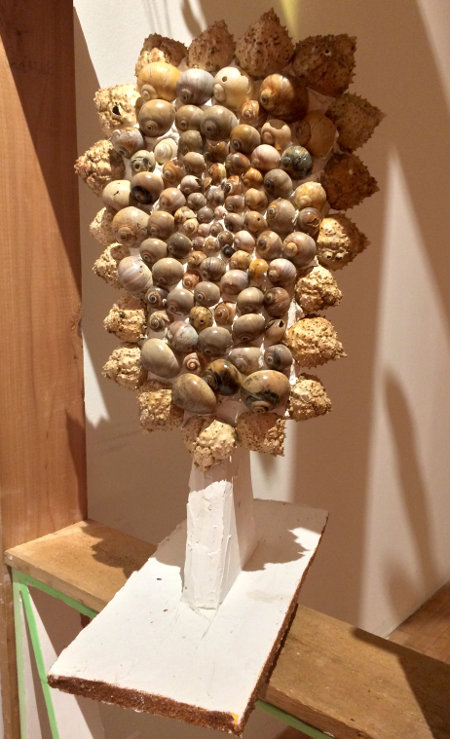![]()
emoticon found on bogchat, enlarged
Clearer views of the artworks described in a previous post. Thanks to Honey Ramka gallery and Michael Wetzel.




Top to bottom:
Mirror Man, 2017, 24" x 12" x 17", foam, plaster, joint compound, seashells (photo cropped for blog)
Head in Sea, 2017, 16.5" x 11" x 10.5", foam, plaster, joint compound, seashells
Studio and exhibition views of Head in Sea, with Head Under Water, 2017, 16.5" x 11" x 10.5", foam, plaster, joint compound, seashells (bottom-most detail cropped for blog)


These sculptures by Michael Wetzel appeared in a two-person show (with Jeffrey Tranchell) called Standards of Living at Honey Ramka gallery last year. Of the artworks in the show, these objects most drew my eye and lingered in my thoughts afterward. These are blurry screenshots I made from the gallery's photos and don't do justice to the intricacy of the work, but serve as visual notes to accompany a passage from Fiasco (1986), a Stanislaw Lem novel I am reading for the first time. Lem is describing a field of bizarre, fanciful-seeming mineral deposits on the surface of Saturn's moon, Titan.
For the very reason that here nothing served a purpose -- not ever, not to anyone -- and that here no guillotine of evolution was in play, amputating from every genotype whatever did not contribute to survival, nature, constrained neither by the life she bore nor by the death she inflicted, could achieve liberation, displaying a prodigality characteristic of herself, a limitless wastefulness, a brute magnificence that was useless, an eternal power of creation without a goal, without a need, without a meaning. This truth, gradually penetrating the observer, was more unsettling than the impression that he was witness to a cosmic mimicry of death, or that these were in fact the mortal remains of unknown beings that lay beneath the stormy horizon. So one had to turn upside down one’s natural way of thinking, which was capable of going only in one direction: these shapes were similar to bones, ribs, skulls, and fangs not because they had once served life -- they never had -- but only because the skeletons of terrestrial vertebrates, and their fur, and the chitinous armor of the insects, and the shells of the mollusks all possessed the same architectonics, the same symmetry and grace, since Nature could produce this just as well where neither life nor life’s purposefulness had ever existed, or ever would.
Addendum: The first sentence is eloquent and rather long and at first it seemed ungrammatical (perhaps it's the translation from Polish). The core of it is "nature could achieve liberation" but the word "nature," surrounded by other clauses, tends to get swamped, or appears to be paired as a synonym with the word "survival" that precedes it. Regardless, once you have it, this passage is a good example of Lem's Borgesian talent for extrapolation from known phenomena to create "unthinkable" vistas and thought processes. It comes at the end of a description of a volcanic crater where minerals have run riot over millions of years of geological time to create landscapes that seem like amalgamations of our worst nightmares. There is beauty there, as well, which got me thinking about those quasi-biological Wetzel sculptures. Lem is one of the most visual sf writers, and his book Solaris has been stripped down by film directors into something like a simple love story, when the essence of it is his poetic description of the surreal life forms constantly churning in the Solarian "ocean" and human inability to ever understand them.
Addendum 2: Clearer photos of the artworks

Tyler Kline, via twitter
This is a jpeg mini-review. Is this a virtual photo? A 3D printed object? Some hybrid of the two? What is the scale? No "materials" or dimensions are given. Regardless, it works for me as a piece, or a prospectus for one. Gestural energy, fecal texture, and quasi-crystalline structure merge into a hyperrealized idea of modernist sculpture. Like a '60s sf book cover in 3D space. The rectangular base suggests "sculpture" but also a painting surface from which this tangle of forms has somehow erupted. It's the kind of project I could imagine Frank Stella wanting to make, but always lacking the imagination or inner turmoil to achieve (Stella, in his "wrecked spaceship" period, mostly just artlessly clumps things together). The 3D sheen also gives the work a CGI horror movie vibe, a la Michael Bay Transformers. There is also a clone tool element, or a parody of the ease with which digital cloning allows the repetition of certain forms.

Attempts to photograph a clear vinyl lathe cut disc by experimental/noise musician James Twig Harper.
I own this disc and wanted to see if I could get accurate documentation of it to post on Discogs' entry for the work (Untitled, 2012)
Discogs describes the piece as:
Double Offset 2, Freeform Lathe cut on clear Acrylic w/ 2 holes. Edition of 20.
This means there are two "tracks" -- one on each side of the disc. The bands of grooves on each side are lined up un-concentrically relative to each other, which you can see because the disc is clear. One of the punch holes lines up concentrically with a track on one side and the other punch hole lines up concentrically with the track on the other side, making each side playable on a turntable. The vinyl slab is crudely cut into an irregular polygon. Soundwise, the tracks appear to be vocals yelled into microphone and amplified into pure distortion, so that the unrecognizable speech acts as an oscillator.